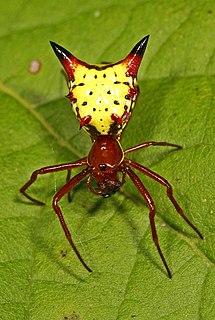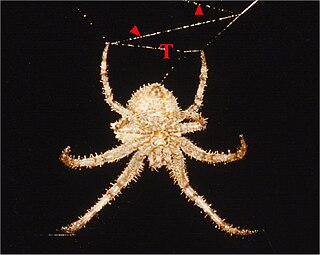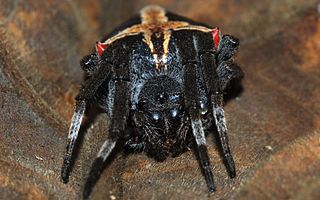
Orb-weaver spiders or araneids are members of the spider family Araneidae. They are the most common group of builders of spiral wheel-shaped webs often found in gardens, fields and forest. "Orb" can in English mean "circular", hence the English name of the group. Araneids have eight similar eyes, hairy or spiny legs, and no stridulating organs.

Eriophora is a genus of orb-weaver spiders first described by Eugène Simon in 1895. It occurs in the Americas, Australasia, and Africa. The name is derived from Ancient Greek roots, and means "wool bearing".

Cyclosa, also called trashline orbweavers, is a genus of orb-weaver spiders first described by Anton Menge in 1866. Widely distributed worldwide, spiders of the genus Cyclosa build relatively small orb webs with a web decoration. The web decoration in Cyclosa spiders is often linear and includes prey remains and other debris, which probably serve to camouflage the spider. The name "Cyclosa" comes from Greek 'to move in a circle', referring to how it spins its web.

Micrathena, known as spiny orbweavers, is a genus of orb-weaver spiders first described by Carl Jakob Sundevall in 1833. Micrathena contains more than a hundred species, most of them Neotropical woodland-dwelling species. The name is derived from the Greek "micro", meaning "small", and the goddess Athena.
Bertrana is a genus of Central and South American orb-weaver spiders first described by Eugen von Keyserling in 1884. It includes some of the smallest known araneid orb-weavers. Bertrana striolata females are 4.5 mm long or less. The eight eyes are in two rows. The abdomen is white on top and on the sides, with multiple hieroglyphic-like lines and bars of many different shapes and length. In females, these are red, in males, black.

Kaira, sometimes called frilled orbweavers, is a mostly neotropical genus of orb-weaver spiders first described by O. Pickard-Cambridge in 1889. It includes sixteen described species that occur from South America up to the southern and eastern USA. It is presumably related to Aculepeira, Amazonepeira and Metepeira.

Dolichognatha is a genus of tropical and subtropical long-jawed orb-weavers that was first described by Octavius Pickard-Cambridge in 1869. Originally placed with the Archaeidae, it was transferred to the Araneidae in 1967, and to the Tetragnathidae in 1981.

Acacesia is a genus of orb-weaver spiders first described by Eugène Simon in 1895. It contains six species with a mostly neotropical distribution, ranging from South America to Mexico. One species, A. hamata, is found in the US as well.

Glenognatha is a genus of long-jawed orb-weavers that was first described by Eugène Louis Simon in 1887. It was considerably revised in 2016.

Parawixia is a genus of orb-weaver spiders first described by F. O. Pickard-Cambridge in 1904. Most species are found in the Neotropics but one species, Parawixia dehaani, is found in Australasia and tropical Asia as far west as India.
Synotaxus is a genus of araneomorph spiders in the family Synotaxidae that was first described by Eugène Louis Simon in 1895. Originally placed with the tangle web spiders, it was moved to the Synotaxidae in 2017.
Opas is a genus of long-jawed orb-weavers that was first described by Octavius Pickard-Cambridge in 1896. Though few males have ever been studied, they are much smaller than females. Their pedipalps have a paracymbium, and a conductor that projects from the tegulum, enclosing the embolus. They sit at the center of orb-shaped webs, many attached to low plants. Their webs are relatively flat, though rotated 45 degrees from horizontal. It has previously been synonymized with Leucauge.
Dubiepeira is a genus of South American orb-weaver spiders first described by Herbert Walter Levi in 1991.
Kapogea is a genus of orb-weaver spiders first described by Herbert Walter Levi in 1997.
Metazygia is a genus of orb-weaver spiders first described by F. O. Pickard-Cambridge in 1904. They physically resemble members of Nuctenea, but they do not have fine setae on the carapace.
Micrepeira is a genus of orb-weaver spiders first described by E. Schenkel in 1953.
Pronous is a genus of South American and African orb-weaver spiders first described by Eugen von Keyserling in 1881.
Spinepeira is a genus of South American orb-weaver spiders containing the single species, Spinepeira schlingeri. It was first described by Herbert Walter Levi in 1995, and has only been found in Peru.
Tatepeira is a genus of Central and South American orb-weaver spiders first described by Herbert Walter Levi in 1995.
Wagneriana is a genus of orb-weaver spiders first described by F. O. Pickard-Cambridge in 1904.








